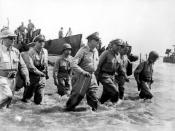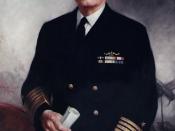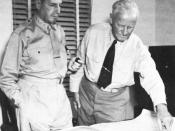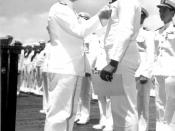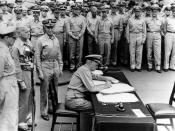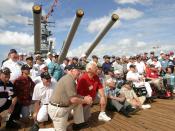Admiral Chester W. Nimitz: Architect of U.S. Victory in The Pacific "Tell Nimitz to get the hell out to Pearl and stay there till the war is won."ÃÂ With this December 17, 1941 order to Secretary of the Navy Frank Knox, President Roosevelt made one of his finest decisions relative to American military strategy in World War Two. Fleet Admiral Chester Nimitz would command "thousands of ships and aircraft and millions of men, amounting to more military power than had bee wielded by all the commanders of all the previous wars."ÃÂ Nimitz would plan and direct US military strategy designed to break down Japanese strength and ultimately destroy the Japanese ability to defend her outposts. Although the atomic bomb would force Japan's surrender in September of 1945, it was Nimitz' strategy that allowed the US to control Tinian from which the bombing aircraft would depart. Indeed, by the time the atomic bombs were used, Nimitz' forces were ready to invade Japan.
When Nimitz took command the Pacific Ocean from Japan to Wake Island was under Japanese control. By September 1945, Japan was open to invasion with her Pacific Islands under Allied control. Admiral Chester Nimitz, with Admiral King and, to a lesser extent General Douglas MacArthur, led the American counter-invasion.
Nimitz believed in unity of service"ÃÂfrom requiring that reservists wear identical uniforms as regular navy to melding such diverse personalities as those of Admiral Halsey and Admiral Spruance into working partners. This desire for unity would allow Nimitz to deal with the difficult General MacArthur, the officious Admiral Blocker and the harsh Admiral King"ÃÂhis immediate superior. This belief served him well, starting with his insistence that Captain Randall Jacobs assume his duties as Chief of the Bureau of Navigation as he left for Pearl Harbor. Despite being told that the President did not like Jacobs, Nimitz believed that only Jacobs could do the job he had formerly held.
Nimitz was expected to use what was left of the Pacific fleet to protect US possessions and maintain communication lines with the West Coast and Australia. Offensive planning would await the availability of new ships. As Nimitz traveled to Pearl Harbor, the relief of Wake Island was recalled. Nimitz was informed of this fact just as he prepared to meet with his predecessor Admiral Kimmel. In reference to the bombing of Pearl Harbor, Nimitz told Kimmel that "The same thing could have happened to anybody."ÃÂ Conscious of the moral problems among Kimmel's staff and knowing that unity must be achieved, Nimitz told the staff that he had "complete and unlimited confidence"ÃÂ in them and would retain them. In fact, Nimitz came to believe that if Kimmel had known of the Japanese fleet and put out to sea to meet them, the consequences would have been far worse than the surprise attack.
Ordered to guard the Hawaiian Islands and protect shipping between Hawaii and the US and between the US and Australia as far south as Samoa, Nimitz had three carrier groups in which to do this--the Saratoga, the Lexington and the Enterprise. These carrier groups, plus the soon to be available Yorktown, would also be used to stage raids against Japanese held islands in the Central Pacific. Until the new fleet could be organized, Nimitz would have to weather the first lean months of his command with nuisance raids until his new fleet was available. He did, however, order US submarines to reconnoiter the Marshall Islands and asked his staff to prepare for offensive actions upon arrival in Pearl Harbor.
